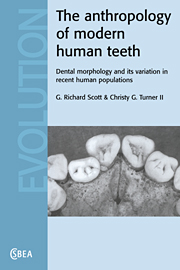 The Anthropology of Modern Human Teeth
The Anthropology of Modern Human Teeth Book contents
- Frontmatter
- Dedication
- Contents
- Acknowledgments
- Prologue
- 1 Dental anthropology and morphology
- 2 Description and classification of permanent crown and root traits
- 3 Biological considerations: ontogeny, asymmetry, sex dimorphism, and intertrait association
- 4 Genetics of morphological trait expression
- 5 Geographic variation in tooth crown and root morphology
- 6 Establishing method and theory for using tooth morphology in reconstructions of late Pleistocene and Holocene human population history
- 7 Tooth morphology and population history
- Epilogue
- Appendixes
- References
- Index
1 - Dental anthropology and morphology
Published online by Cambridge University Press: 05 September 2015
- Frontmatter
- Dedication
- Contents
- Acknowledgments
- Prologue
- 1 Dental anthropology and morphology
- 2 Description and classification of permanent crown and root traits
- 3 Biological considerations: ontogeny, asymmetry, sex dimorphism, and intertrait association
- 4 Genetics of morphological trait expression
- 5 Geographic variation in tooth crown and root morphology
- 6 Establishing method and theory for using tooth morphology in reconstructions of late Pleistocene and Holocene human population history
- 7 Tooth morphology and population history
- Epilogue
- Appendixes
- References
- Index
Summary
Introduction
Physical anthropology focuses on human biological variation through time and space. Except for those who work in primate paleontology, the temporal bounds of the field are set by hominid origins some five to eight million years ago and extend across time through a diversity of hominid fossil species to modern members of Homosapiens. The geographic bounds extend to all parts of the globe habitable by human populations. Methods employed for conducting research on human variation run the gamut from anatomical measurements and observations to physiological parameters and DNA sequencing. The subjects of study are hominid fossils and all human skeletal and living populations. Problems revolve around a multiplicity of questions involving facets of human adaptation, variation, and history.
Dental anthropology is a subfield of physical anthropology although many contributors to this area of research come from fields outside of anthropology, notably dentistry, genetics, anatomy, and paleontology. Although dental anthropology strikes outside observers as a specialized field of inquiry, it encompasses a broad range of subjects which, in turn, have invited finer levels of specialization. Some workers concentrate on developmental aspects of the dentition, from tooth germ formation to developmental defects of the crown. Others focus on post-eruptive changes such as ordinary crown wear and culturally-prescribed dental modification. The study of dental pathologies, in particular caries, periapical osteitis, patterns of tooth loss, and periodontal disease, provides yet another avenue of research. Researchers interested in those elements of the human dentition that have some underlying genetic basis study tooth size and morphology (Cadien, 1972; Bailit, 1975; Kieser, 1991; Scott and Turner, 1988; Scott, 1991a; Townsend et al.,1994).
Much evidence has accumulated over the past century to indicate dental development is regulated to a significant extent by the action of genes (chapters 3 and 4). This is true not only for crown and root form in general but extends to the myriad of positive and negative structural variants of a tooth. Dahlberg (1951:140) notes ‘All human dentitions are basically the same. The differences between individuals are in the number and extent of the primary and secondary characters of the tooth groups, which in turn are the reflections of the genetic constitution of the individual.’ From the basic blueprint, or ‘master dental plan’ that characterizes all human dentitions, teeth exhibit morphological and metrical traits that vary within and between populations.
- Type
- Chapter
- Information
- The Anthropology of Modern Human TeethDental Morphology and its Variation in Recent Human Populations, pp. 1 - 14Publisher: Cambridge University PressPrint publication year: 1997
- 1
- Cited by


